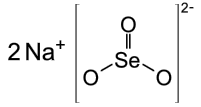Sodium selenite
 | |
| Identifiers | |
|---|---|
3D model (JSmol) |
|
| ChEBI | |
| ChEMBL | |
| ChemSpider | |
| ECHA InfoCard | 100.030.230 |
| EC Number | 233-267-9 |
| KEGG | |
PubChem CID |
|
| RTECS number | VS7350000 |
| UNII | |
| UN number | 2630 |
| |
| |
| Properties | |
| Na2O3Se | |
| Molar mass | 172.95 g·mol−1 |
| Appearance | colourless solid |
| Density | 3.1 g/cm3 |
| Melting point | decomposes at 710 °C |
| 85 g/100 mL (20 °C) | |
| Solubility | insoluble in alcohol, ethanol |
| Structure | |
| tetragonal | |
| Pharmacology | |
| A12CE02 (WHO) | |
| Hazards | |
| Safety data sheet | ICSC 0698 |
EU classification (DSD) (outdated) |
Very toxic (T+) Dangerous for the environment (N) |
| R-phrases (outdated) | R23, R28, R31, R43, R51/53 |
| S-phrases (outdated) | (S1/2), S28, S36/37, S45, S61 |
| NFPA 704 | |
| Related compounds | |
Related compounds |
Sodium sulfite Sodium selenate Sodium selenide |
Except where otherwise noted, data are given for materials in their standard state (at 25 °C [77 °F], 100 kPa). | |
| Infobox references | |
Sodium selenite is the inorganic compound with the formula Na2SeO3. This salt is a colourless solid. The pentahydrate Na2SeO3(H2O)5 is the most common water-soluble selenium compound.
Synthesis and fundamental reactions
Sodium selenite usually is prepared by the reaction of selenium dioxide with sodium hydroxide:[1]
- SeO2 + 2 NaOH → Na2SeO3 + H2O
The hydrate converts to the anhydrous salt upon heating to 40 °C.
Akin to the related salt sodium sulfite, Na2SeO3 features a pyramidal dianion SeO32−.[2] Oxidation of this anion gives sodium selenate, Na2SeO4.
Applications
Together with the related barium and zinc selenites, sodium selenite is mainly used in the manufacture of colorless glass. The pink color imparted by these selenites cancels out the green color imparted by iron impurities.[3]
Because selenium is an essential element, sodium selenite is an ingredient in dietary supplements such as multi-vitamin/mineral products, but supplements that provide only selenium use L-selenomethionine or a selenium-enriched yeast.
The US Food and Drug Administration approved a selenium supplement to animal diets; the most common form is sodium selenite for pet foods. According to one article, "not much was known about which selenium compounds to approve for use in animal feeds when the decisions were made back in the 1970s .. At the time the regulatory action was taken, only the inorganic selenium salts (sodium selenite and sodium selenate) were available at a cost permitting their use in animal feed.” [4]
Safety
Selenium is toxic in high concentrations. As sodium selenite, the chronic toxic dose for human beings was described as about 2.4 to 3 milligrams of selenium per day.[5] In 2000, the U.S. Institute of Medicine set the adult Tolerable upper intake levels (UL) for selenium from all sources - food, drinking water and dietary supplements - at 400 μg/day.[6] The European Food Safety Authority reviewed the same safety question and set its UL at 300 μg/day.[7]
See also
References
- ↑ F. Féher, "Sodium Selenite" in Handbook of Preparative Inorganic Chemistry, 2nd Ed. Edited by G. Brauer, Academic Press, 1963, NY. Vol. 1. p. 432.
- ↑ Wickleder, Mathias S. (2002). "Sodium selenite, Na2SeO3". Acta Crystallographica Section E. 58 (11): i103–i104. doi:10.1107/S1600536802019384. ISSN 1600-5368.
- ↑ Bernd E. Langner "Selenium and Selenium Compounds" in Ullmann's Encyclopedia of Industrial Chemistry (published on-line in 2000) Wiley-VCH, Weinheim, 2002 doi:10.1002/14356007.a23_525
- ↑ Schrauzer, GN (2001). "Nutritional selenium supplements: product types, quality, and safety". Journal of the American College of Nutrition. 20 (1): 1–4. doi:10.1080/07315724.2001.10719007. PMID 11293463.
- ↑ Wilber, C. G. (1980). "Toxicology of selenium". Clinical Toxicology (Free full text (see p. 211))
|format=requires|url=(help). 17 (2): 171–230. doi:10.3109/15563658008985076. PMID 6998645. - ↑ Institute of Medicine (2000). "Selenium". Dietary Reference Intakes for Vitamin C, Vitamin E, Selenium, and Carotenoids. Washington, DC: The National Academies Press. pp. 284–324.
- ↑ Tolerable Upper Intake Levels For Vitamins And Minerals (PDF), European Food Safety Authority, 2006
